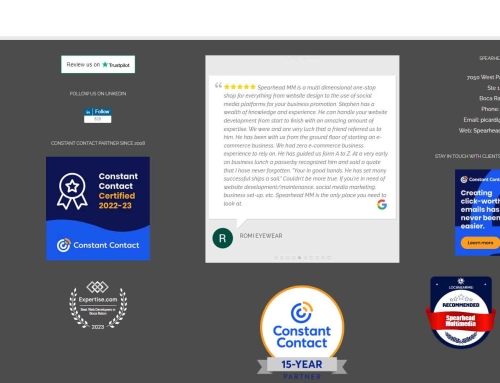Platforms like Twitter, Facebook, and TikTok are powerful ways to reach your targets. Learn how to develop a strategy to use them.
It may sound like hyperbole, but few things have changed the world as much as social media.
Sure, the wheel, gunpowder, and the airplane played essential roles in shaping the course of history, but did any of them allow you to chat with your friend on the other side of the world in real-time Facebook Messenger?
Or easily share photos of your sister’s birthday party with your cousins via Instagram? And none of them allowed you to interact with celebrities as Twitter does.
Unsurprisingly, social networking has become a ubiquitous part of modern life.
And it’s also no surprise that it’s become such an essential part of marketing in the modern world. No marketing strategy is complete without a social media component, from the most prominent global brands to the mom-and-pop down the street.
But developing an effective social media marketing strategy can be tricky – particularly as platforms evolve and popularity waxes and wanes.
This piece will guide you through the basics of social media strategy and give you a step-by-step plan you can implement to drive traffic and maximize exposure.
What Is Social Media Marketing?
Before diving into the how-tos, let’s first cover precisely what social media marketing means – and what it’s used for.
You probably don’t need a dictionary to figure out that it’s a type of internet marketing that uses social media platforms as a tool.
But what makes this better than print advertising or a television commercial? In a word:
Engagement
Unlike traditional forms of marketing, social media allows you to speak with your audience, not at them. You can generate conversations around your brand and what’s important to your customers in a give-and-take format.
It allows you to tell your story while maintaining the narrative responsively and authentically – something you won’t find in other types of marketing.
But that’s not all. Social media has many other benefits for marketing, including:
Increased Brand Awareness
There are more than 4 billion social media users worldwide. This means you could theoretically reach more than half of the global population.
Global Marketing Day
February 16-17, 2023. Unique 24-hour online conference with the world’s leading marketers. SEMRUSH powers it.
It’s unlikely that your Dayton, Ohio-based accounting company’s Facebook page will attract new customers from Hyderabad, India, but it will likely help build your local awareness.
And as marketing, you know that increased awareness leads to more leads, which leads to more sales.
Good ROI (Return On Investment)
One of the most significant advantages of social media marketing is that it allows you to build an audience without a big budget.
Creating a business profile is free on most platforms, and while you can use paid advertising, it’s not essential.
Instead, you can build an audience and expand your reach simply by consistently posting content your targets will find valuable.
Improved SEO
Social platforms can also help your search engine optimization efforts.
While there’s no direct correlation between your search engine ranking and social media, in that your ranking is not directly affected by what you post on YouTube or Instagram, there is a connection.
For one, social media allows you to boost your content. This leads to more traffic and engagement, which are positive user signals.
It also gives you more opportunities for generating backlinks, not to mention that your profile could rank in its own right for search terms.
Better Customer Service
From troubleshooting an issue to providing tips and tricks, social media gives customers an easy way to reach out to you.
It can effectively turn a negative experience into a positive one while allowing you to keep your finger on the pulse of patterns in buying, using, and potential issues.
How To Create A Social Media Strategy
The benefits of implementing social media into your marketing efforts are apparent, but you can’t just haphazardly post images, polls, and status updates and expect to get results.

It would be best if you had a clearly defined strategy. Here’s how to create one:
1. Identify Your Audience
The very first thing you need to do is determine who you are targeting on social media. This will help you create content that will interest and engage them.
Consider their wants, needs, and challenges and who they are. Many marketers find it helpful to create customer personas, which are representations of the major subsets of your audience.
Group your customers into four or fewer clusters and identify general similarities. Be sure to include things like:
- Demographics – age, gender, job title, salary, location, etc.
- Interests – What type of content would interest them?
- Their goals about your content – Are they looking for a new job? To improve their fitness? To learn a skill?
- The platform of choice – Facebook, TikTok, LinkedIn, etc.
- Preferred format – Are they more likely to watch videos or read text posts?
One caveat: don’t get too granular trying to target outliers or exceptions. Instead, look for generalities that are consistent within each grouping.
2. Set Specific, Measurable Goals
To track your effectiveness and get the best return on investment, you first need to decide what you want to accomplish through your presence on social media. This can be a single goal, or you can have multiple objectives.
Whatever you choose must meet three criteria: 1. Be achievable, 2. Be measurable, and 3. Be relevant to your brand.
Some of the most common social media marketing goals are:
- Increasing traffic to your website.
- Generating new leads.
- Making conversions (signups, sales, etc.).
- Boosting engagement.
- Controlling conversations about your brand.
Your goals should be as specific as possible and align with social media metrics so you can track your campaign’s effectiveness.
3. Check Out The Competition
There’s a good chance some of your competitors also use social media as a marketing strategy.
Do a deep dive into their profiles and content. This will help you get a feel for the kind of content your audience likes and the ones that don’t interest them.
Look at which platforms get the best results and which are underserved. Is this because your targets prefer one app to another, or are your rivals missing an opportunity?
But don’t just look once and move on. This should be an ongoing process and part of your social listening process.
4. Decide Which Platforms You’ll Use
By this point, you should know which social apps your target audience is using. Those are the ones you should focus on.
You don’t have to be on every platform. Did you get that? You do not need to have a social presence on every platform. Some of them will not be used by your target, so if you’re targeting retirees on TikTok, you’re likely wasting your time.
That said, most brands find it beneficial to have a presence on the “big four” – Facebook, Twitter, Instagram, and LinkedIn.
Understand the strengths and weaknesses of each platform and how they work into your strategy.
5. Optimize Your Profile
Now that you know where you’ll post content, it’s time to set up or optimize your profile. Because this is the face your show the cyber world, you must include all the information your audience needs right up front.
Ensure you include your business name, contact details, and anything else visitors want to know.
Using a keyword research tool, determine which words and phrases your customers use in search and include them in your profile.
Next, make sure you’re using consistent branding, with hi-res images that won’t look skewed as thumbnails. Your goal is to make your brand instantly recognizable across all touchpoints.
This is also an excellent point to look through any content you have previously posted and get rid of those that aren’t on-brand.
6. Plan Your Content
Your content will depend on many factors, including what you’re promoting and your audience’s preferences.
You also want to ensure everything works towards one of the goals you outlined in step 2.
Depending on the platform(s) you’re using. Your content could include memes, educational videos, links to blog posts, or anything else your audience will find helpful.
You should include informative and entertaining content, as well as things that are directly promoting your brand. This will usually generate better engagement and sharing than strictly sales pieces.
7. Create A Social Media Content Calendar
The next thing you should do is make a content calendar that clearly outlines when you’ll be posting and where you’ll be posting it.
Your goal is to catch the attention of the biggest audience and generate maximum engagement. This will vary, depending on several factors, including your business, your audience, and the time of year.
However, you should ensure that you’re regularly posting content. Try to find the sweet spot between posting too much (and annoying your audience) and posting too little (and being unimportant).
Don’t worry if you can’t figure this out exactly right now. It may take some experimentation on your part.
And speaking of things that will require some testing, your content calendar should include not just the date on which you will post things but what time of day you will post them.
Every brand has an optimal post time at which the most significant number of targets will see it. There may be one time per week or several per day – it all depends on your audience.
8. Track Your Performance
Once you start pushing posts live, you’ll gather information about what’s working and start identifying trends.
The best and easiest way to monitor this is by looking at your metrics. Most social media platforms offer some form of analytics for commercial users, in which you can view statistics on reach, impressions, and response rates.
The ones that matter to you will depend on your goals.
If your goal is to increase engagement, you’ll want to track likes, comments, and reshares. For example, if you’re following the number of web visitors who sign up for your newsletter, you’ll want to measure the click-through, conversion, and bounce rates. If you’re using paid ads, you’ll want to keep an eye on your cost-per-click.
Look for commonalities among your most successful and least prosperous posts. This will give you insight into the type of social media content you should post.
9. Tweak And Rework Your Strategy
Social media marketing isn’t the type of thing that pays instant dividends. It requires some time to understand what works and what your targets are like.
And once you feel confident your content is on-target, on-brand, and generating results, your social media strategy will still require regular adjustments based on changing preferences, trends, and audience needs. As your business evolves, your social media presence should evolve with it. You may want to branch out onto new platforms, add paid advertisements, or change how frequently you post. You will need to revisit your plan and rethink it regularly.
The goal is to keep looking for new ways to maximize the impact of your presence on social platforms with an evolving social media strategy. And while that’s a job that is never done, over time, you’ll gain a feel for what you’re doing that will help you generate more consistent results.
Keep Your Eyes On The Prize
It’s easy to get distracted in the world of social media, and that makes creating and implementing a social media strategy for it difficult.
You can get so close to your content that you lose the forest for the trees, which makes it essential to step back regularly and look at the bigger picture.
Everything you post should have a purpose and actively work towards achieving one of the goals of your social media strategy.
But by putting in the work, keeping an open mind, and not being afraid to take risks, the social media strategy you develop will surely reap the rewards for your business.
Happy posting.

Article by Brian Frederick
An expert in all things digital marketing-related, Brian has been writing about SEO, social media, integrated campaigns, and PPC for most of the 21st century. A personal believer in the Oxford comma who abstains from it in his professional life, he specializes in journalism and advertising copywriting.






















Leave A Comment
You must be logged in to post a comment.